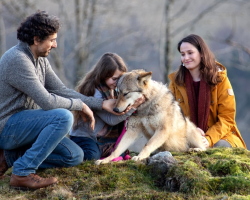Rabies is a disease that is dangerous for both animals and people. Having recognized the signs of rabies in the animal, it is urgent to take warning measures and isolate the patient as soon as possible.
Content
- The cause of rabies in dogs
- The first signs of rabies in dogs
- Signs of rabies in dogs. Symptoms. What to do?
- How to check the dog for rabies?
- The incubation period of rabies in dogs
- Do dogs need rabies vaccination and when to do it?
- Rabies vaccination for dog: side effects
- Can a vaccinated dog get rabies?
- Treatment of rabies in dogs
- Frenzy Prevention in dogs
- Video: a veterinarian on the prevention of rabies: how to recognize rabies, what to do and where to go
Rabies (hydrophobia) It is always associated with dogs - the main carriers and distributors of this deadly disease. In fact, rabies is dangerous for all warm -blooded creatures.
There are several forms of rabies:
- violent - The most common form, proceeds in 3 stages. It begins with an apathetic state, non -standard behavior of the animal. In the course of the development of the disease, aggression appears, paralysis of the limbs, coma and death occur
- quiet - The dog is not aggressive, eats well, but swallows heavily. The hind limbs and jaws lose their sensitivity
- return - characterized by alternate improvements and deteriorations of the state of the animal, inactivity and apathetic
- abortive - an extremely rare form in which the animal has recovery
- atypical - A sluggish form can last up to six months. All this time the dog can have diarrhea and vomiting

IMPORTANT: all forms of fusion are equally dangerous for humans.

The cause of rabies in dogs
The main cause of rabies in dogs is a bite of a sick animal. The greatest probability of infecting rabies in dogs living nearby with forests and steppes, in which sick foxes, wolves, jerks, raccoons and other wild mammals of warm -blooded live. Also in the increased risk zone are hunting dogs.
The dog washes to become infected with rabies by eating a sore mouse or rat. In this case, there will be no traces of a bite or scratches, which will not be difficult to diagnose.

Important: even those dogs that are contained in apartments run the risk of getting firm after accidental contact with a sick animal. A small particle of the carrier saliva is enough to convey the disease.
A serotypic virus that causes rabies is contained in the blood, biological fluid and saliva of a sick animal. Dogs can even simply lick each other - this will be enough for infection.

The first signs of rabies in dogs
First (early) stage The course of rabies in a dog is characterized by the presence of such symptoms in the animal:
- increased irritability that is previously not characteristic of the dog
- fear of sun and bright artificial lighting
- chills
- restless behavior, fussiness
- rejection of any food
- a hoarse voice, unusual barking
- vomit
- liquid chair
- the inability to swallow food or swallow saliva
- cough
To the signs later period Related:
- paralysis of the hind limbs, gradually spreading throughout the body
- constantly open mouth, omission of the jaw
- strong department of saliva, education "foam" on the lips
- lack of aggression

Late symptoms The development of the most common violent rabies is:
- anxiety and even panic fear at the sight of water or the sound of murmur
- foam on the mouth
- evil Oscille, readiness to attach, aggression
- excessive irritability
- causeless attacks of people and other animals
- inadequate behavior: attempts are stones, chew your tail
Important: if you find signs of rabies in your dog, urgently consult a veterinarian and isolate the animal.
Signs of rabies in dogs. Symptoms. What to do?
How to check the dog for rabies?
If the dog lives in a dysfunctional area, contacted other animals, in the district there were registered cases of rabies and its behavior after that seems strange, it is necessary to check the dog for rabies.
First of all, the skin of the animal should be carefully examined to detect traces of bites, fresh wounds, scratches and other damage. If any suspicious violations of the integrity of the skin are found, you need to contact the veterinarian as soon as possible.

IMPORTANT: Once on the skin and hair of the dog, the rabies virus remains viable for about 2 hours. Therefore, before taking the animal in your hands, you need to worry about your own safety: put on long trousers and sweater, do not touch the dog with your bare hands.
It is impossible to determine whether the animal is sick with rabies. There are no tests or tests, the results of which could confirm or refute the presence of the disease. The exact answer, whether the dog is infected with rabies, can only give an examination of animal brain cells.
The incubation period of rabies in dogs
The incubation (latent) period of rabies in dogs, like other animals, lasts from 3 to 6 weeks. Prior to the appearance of obvious signs of the disease, the virus is already in saliva, blood and physiological fluid of the dog. At this time, the animal can already infect others.

Do dogs need rabies vaccination and when to do it?
Vaccination is the only way to protect his pet from infection with rabies. Carry out from rabies in veterinary clinics. The only condition for vaccination is the absolute health of the dog.
Important: 10 - 14 days before vaccination, the dog needs to carry out deworming.
Persistent immunity against rabies virus is produced by the body of a vaccinated animal after 21 days from the moment of vaccination.
In the vaccination passport, the veterinarian makes an entry about the procedure indicating the date of vaccination, validity and type of vaccine.
Important: if the vaccination is planned to be carried out by a puppy not protected from other viral infections, it is better to call the veterinarian to the house, and not to take the animal to the clinic, at the risk of infection with no less dangerous diseases.
In state veterinary hospitals, vaccination from rabies in the domestic vaccine is free.

Rabies vaccination for dog: side effects
By sending a dog to vaccination from rabies, it is important for the owner to understand that a foreign substance will be introduced into her body and the appearance of any complications should not be surprised after vaccination.
After vaccination are possible:
- improving body temperature
- salivation
- stool disorder
- ears and eye swelling
- changing behavior
A common reaction to the introduction of rabies vaccine is allergies. It manifests itself in the first 5 to 10 minutes after the injection. Her first symptoms will immediately notice the veterinarian and relieves the attack by introducing an antihistamine.
Important: side effects are rarely observed when using a foreign inactivated vaccine ( Nobivak, eurican).

A variant of the norm is the appearance of cones or seals on the skin of a dog at the place of introduction of a vaccine. This reaction is not considered a complication and after time it passes.
If at the time of vaccination the dog was already infected with rabies, but the symptoms of the disease have not yet appeared, after vaccination the animal will get sick or even die.

Can a vaccinated dog get rabies?
A vaccinated dog can become infected with rabies if contact with a sick animal occurred earlier than 21 days after vaccination.
Perhaps infection with rabies of vaccinated dogs, but such cases are single. Vaccination is a fairly reliable method of rabies protection.

Treatment of rabies in dogs
There is no treatment of rabies in dogs. Moreover, it is prohibited due to a huge risk of infection of the Net-clinic medical personnel. The dog’s patient is lifted up to reduce its torment and protect others from possible infection.

Frenzy Prevention in dogs
The best preventive method for preventing rabies is vaccination. It is cheap, safe and effective.
IMPORTANT: Hunting Norny Dogs must be vaccinated once a year, guard and decorative - every 2 years.

The contacts of their dog with wild and stray animals should also be avoided. Among the homeless dogs strayed into the pack, there are often infected ones. Even a single, insignificant contact with such a dog can become fatal for a domestic unvaccinated animal.
Residents of dysfunctional regions should pay special attention to the behavior and condition of their dogs, note all cases of the appearance of wild animals in residential areas and report them to veterinarians.

Rabies is a deadly disease. She does not spare any dogs or people. There is no rabies treatment, but the responsible approach of domestic animals to vaccination can significantly improve the incidence of rabies and prevent the further spread of the disease.







